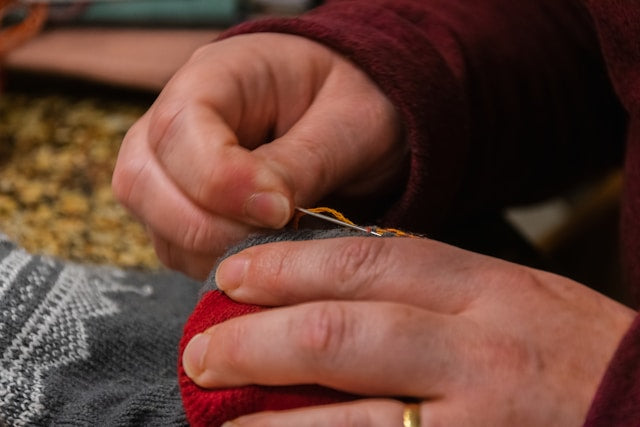

· By Brooke Hamilton-Benjestorf
Mending a Throwaway Culture
When we break or damage an item, in our fastfood-throwaway culture, we quickly offer it up to the precarious, soon-to-topple, God of Landfills and buy a new one. Even if just a piece of it breaks, one that can be replaced or mended, our culture-lenses are tinted to view the damaged item as trash. These waste-colored glasses assure us that it makes more financial or energetic sense to replace the whole thing than it does to mend it. For it is at the altar of the revered God of Convenience that we are directed to kneel, one of modern age’s penultimate deities.
If we question this logic, the culture-at-large shakes another packet of aspartame into our Kool Aid and tells us to drink up. It whispers, “Surely it’s lovely to care for the earth. But this is real life. Do you actually have the time and energy to spend on this repair when your productivity could be funneled elsewhere?” This is the modeled way of doing things, and it is joyless and entirely unsustainable.
You get a dinger on the back bumper of your old, trusted jalopy and it’s totaled, a totaled car being one whose cost to repair it is greater than the value of the car itself. But then, what is the value of a car? To me, the value of my decade-old, vanilla-colored minivan lies is in these facts: it safely motors my family from Point A to Point B while blasting life-giving tunes from its spotty speakers, it eases my ability to spend time with the people I love, and it enables me to gather ingredients to make a satisfying meal at the end of the day. This is not, however, what Bluebook sees as the value of my car. They don’t think she’s such a catch. But you know what? They’re wrong.
In order to accurately ascertain an item’s value, we must first extract ourselves from the capitalistic waters we swim in and peer in from the other side of the glass. Value in our culture is defined by its return - for the most part, it’s strictly monetary. But value is a principle intrinsic to life, an idea that exists outside of our relationship to money, and even outside of human existence. Value lived on this planet before we did. Value is quality of life, and the breadth of life spreads far beyond the reach of the human world.
It is tricky, though. It’s a knee-jerk reaction to throw away a thing when it breaks, because the dogma of convenience is preached with greater ardor than any religious teaching today. We have to practice discernment and intentionality - muscles that easily go unexercised if you’re just cruising with the times - in order to experience the true value of an object, or even the value of a stretch of time.
Most may call the sacred practice of setting aside time to mend our broken things (clothing, pottery, furniture, wounds, hearts) a lost one - a thing of the past - but we disagree. Juniper Station has offered and continues to offer a series of classes and workshops on fixing and mending. We’d like to offer you a new pair of glasses - one whose lenses reveal objects as more than expendable.
Learning to effectively and beautifully mend our clothing packs an enormous punch in the ecological scheme of things, as almost 2 million tons of textile waste is created every year [1] making the fashion industry one of the top five biggest landfill contributors. Nicole Kelly of Yolotli recently led a two-part workshop for JS on visible mending for clothing and other home textiles. She utilizes the Japanese methods of sashiko, which is a form of decorative reinforcement stitching, and boro, which involves patching textiles together to bring longevity to our fiber goods. These methods also add artistic value and uniqueness to our things. I’ve found that when I love an item for its singularity and have spent time nurturing it, I rarely take it for granted.
Another oft-tossed item is that of broken pottery. At the end of this month, Danielle Eastman of Covet Ceramics will lead a class on kintsugi, the ancient (and stunning!) art of mending broken pottery with metallic dust, such as powdered gold or silver. If you’re in Napa, this is an excellent opportunity to grow your eco-knowledge while you learn how to do a beautiful thing. We could all use that.
I’ve found that being selective about the things I have, and caring for them, changes my mind about all kinds of surprising things. This may sound like an overstatement, but I assure you it’s not. The more I engage with the value in the objects I have, the pickier I am about what I purchase. I start to notice what it is exactly that gives my objects value, and those qualities become easier to spot out in the world.
I let an item sit in my virtual cart for a week, and then return to it. Does it still present as a worthwhile possession? Honestly, lots of the time I find that it doesn’t. And I remove it from my cart. But the things that I buy, I love. I use them until they can no longer bear another repair. I use them until they have given all they have to give. They die honorable deaths; they’re not thrown into the landfill alive and full of potential. This affects my life in a multitude of ways. It even affects the way I see myself. I like this version of myself better. I am at peace with this woman, who carefully surrounds herself with useful treasures. She is someone I’d like to have a cup of tea with.
And ultimately, what greater gift is there than to find peace when we sit down with ourselves and learn to mend?
[1] https://earth.org/statistics-about-fast-fashion-waste/
Photo by Joseph Sharp on Unsplash